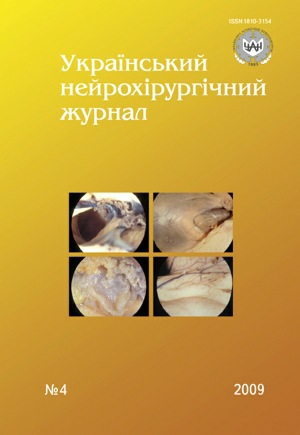Ultrastructural peculiarities of the organization process in a zone of spinal cord traumatic injury and synthetic macropourus hydrogel implantation
DOI:
https://doi.org/10.25305/unj.108013Keywords:
experimental traumatic spinal cord injury, renewing neurosurgery, synthetic macropourus hydrogel, astrocytes, fibroblasts, axonal growth, myelinisationAbstract
Ultrastructural features of the tissue organization process in a zone of rat’s spinal cord left-side partial cut and immediate synthetic macropourus hydrogel implantation were investigated. During first three weeks after injury modelling the implantant produces gentle conjunctive tissue which keeps going for some more months, and that offers favorable conditions for regenerative growth of neural fibre of small and middle diameter. At animals from control group the spinal cord traumatic injury zone organization conducted with the help of primarily glial components that led to a quick formation of compact gliofibrotic scar. At later observation terms gentle conjunctive tissue in the gel was replaced by rude fibre-like components that was accompanied by delayed degeneration of some myelinated fibres.
References
Гайер Г. Электронная гистохимия. — М.: Мир, 1974. — 348 с.
Boyd J.G., Lee J., Skihar V. et al. LacZ-expresing olfactory ensheathing cells do not associate with myelinated axons after implantation into the compressed spinal cord // PNAS. — 2004. — V.101, N7. — P.2162–2166.
Cheng H.,Cao Y., OlsonL. Spinal cord repair in adult paraplegic rats: Partial restoration of hing limb function // Science. — 1996. — V.273. — P.510–513.
Cocsis J.D., Akiyama Y., Lankford K.L., Radtke C. Cell transplantation of peripheral-myelin-forming cells to repair the injured spinal cord // J. Rehab. Res. Dev. — 2002. — V.39, N2. — P.287–289.
Hurtado A., Moon L.D., Maquet V. et al. Poly(D,L-lactic acid) macroporous guidance scaffolds seeded with Schwann cells genetically modified to secrete a bi-functional neurotrophin implanted in the completely transected adult rat thoracic spinal cord // Biomaterials. — 2006. — V.27, N3. — P.430–442.
King V.R., Phillips J.B., Hunt-Grubbe H. et al. Characterization of non-neuronal elements within fibronectin mats implanted into the damaged adult rat spinal cord // Biomaterials. — 2006. — V.27, N3. — P.485–496.
Li Y., Field P.M., Raisman G. Repair of adult rat corticospinal tract by transplants of olfactory ensheathing cells // Science. — 1997. — V.277. — P.2000–2002.
Marburg O. Multiple sklerose (Encephalomyelitis periaxialis scleroticans disseminata) // Handbuch der Neurologie / Eds. Hrgeg. von O. Bumke, O. Foerster. —Berlin: Verlag von Julius Springer, 1936. — Bd.13. — S.546–693.
Moore M.J., Friedman J.A., Lewellyn E.B. et al. Multiple-channel scaffolds to promote spinal cord axon regeneration // Biomaterials. — 2006. — V.27, N3. — P.419–429.
Reynolds E.S. The use of lead citrate at high pH as an electronopague stain in electron microscopy // J. Cell Biol. — 1963. — V.17. — P.208–212.
Stokols S., Tuszynski M.H. Freeze-dried agarose scaffolds with uniaxial channels stimulate and guide linear axonal growth following spinal cord injury // Biomaterials. — 2006. — V.27, N3. — P.443–451.
Tsai E.C., Dalton P.D., Shoichet M.S., Tator C.H. Matrix inclusion within synthetic hydrogel guidance channels improves specific supraspinal and local axonal regeneration after complete spinal cord transection // Biomaterials. — 2006. — V.27, N3. — P.519–533.
Woerly S., Doan V.D., Sosa N. et al. Reconstruction of the transected cat spinal cord following NeuroGel implantation: axonal tracing, immunohistochemical and ultrastructural studies // Int. J. Dev. Neurosci. — 2001. — V.19, N1. — Р.63–83.
Woerly S., Doan V.D., Sosa N. et al. Prevention of gliotic scar formation by NeuroGel allows partial endogenous repair of transected cat spinal cord // J. Neurosci. Res. — 2004. — V.75, N2. — P.262–272.
Downloads
Published
How to Cite
Issue
Section
License
Copyright (c) 2009 V. I. Tsymbalyuk, A. T. Nosov, V. M. Semenova, Yu. Ya. Yaminsky, V. V. Vaslovich, V. V. Medvedev

This work is licensed under a Creative Commons Attribution 4.0 International License.
Ukrainian Neurosurgical Journal abides by the CREATIVE COMMONS copyright rights and permissions for open access journals.
Authors, who are published in this Journal, agree to the following conditions:
1. The authors reserve the right to authorship of the work and pass the first publication right of this work to the Journal under the terms of Creative Commons Attribution License, which allows others to freely distribute the published research with the obligatory reference to the authors of the original work and the first publication of the work in this Journal.
2. The authors have the right to conclude separate supplement agreements that relate to non-exclusive work distribution in the form of which it has been published by the Journal (for example, to upload the work to the online storage of the Journal or publish it as part of a monograph), provided that the reference to the first publication of the work in this Journal is included.









